Recently I wrote about gold, so it seems to make sense I would also write about silver. Buying or investing in silver works a lot the same way as with gold, but silver is much, much cheaper. Right now gold costs about 66 times as much per ounce as silver, so you get a lot more silver for your money. There are exchange traded funds (ETFs) with billions of dollars invested in bars of silver, but the bars of silver are bigger (1000 ounces instead of the standard 400 ounces for gold bars) and there are a lot more of them to store. Plus silver is not as heavy, so the silver takes up more room per ounce. Because silver had gone down 40% last year, it seemed like a good contrarian investment and more likely to go up than the stock market, which went up 30% last year and seemed pricey. So I bought some shares of the ETF iShares Silver Trust (SLV) last month around the same time I bought the gold coins. Silver has continued to go down since that time and I am down about 8%. It could be a bumpy ride. While silver hit a high around $40 per ounce 3 years ago and is now trading at around $20 an ounce, back in 2004 it was only $5 an ounce. It will never be worthless, but there is probably more downside than likely upside. Sometimes when the stock market does poorly, metals go up in value as people look for a tangible investment that will still protect them from inflation. But a lot of the demand for the metal is based on strong economic activity so in 2008, the price of precious metals went down just like the stock market did.
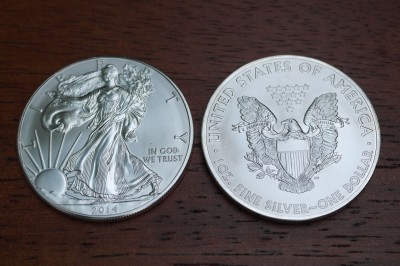
Other than ETF’s or buying 1000-ounce ingots of silver, you can also buy coins from mints. Like with gold, the best deal going seems to be through JM Bullion. They sell American Silver Eagles for $3.49 above the spot price of silver. But with silver at $19.50 per ounce, that’s an 18% increase in the price, whereas the American Gold Eagle’s $60 premium only comes out to a 4.5% increase in price. So it is much less efficient investing in silver coins, but if you don’t have enough money to buy a whole ounce of gold, silver may not be too bad. And the end-of-the-world guys like silver precisely because you can buy a lot of it and they feel like silver coins will be what people will use to pay for things after all of the governments fall (gold will just be for big ticket items).
Maybe because of the lower price and the doomsayers’ preference for silver, the US Mint sells way more silver coins than gold ones (43 million silver coins vs. 1.7 million gold coins in 2013). The government used to stockpile silver and other strategic materials for defense purposes as part of the Defense National Stockpile Center, but after 15 years of minting silver coins (starting in 1986), they had used all of that up and now they purchase silver on the open market (proposed in a bill by Harry Reid of Nevada).
In addition to my diminishing shares of SLV, I thought I might like to get some silver coins just to have. The American Silver Eagles seem to be preferred but have one of the higher prices above the spot prices. But they are really pretty, based on the Walking Liberty half dollar minted from 1916-1947. The US Mint also sells 5-ounce silver coins that look exactly like the national park quarters, except GIANT: 3 inches in diameter. However these go for an even bigger premium over the spot price of silver than the Eagles (they are marketed as bullion, but really seem to be collector’s items). At JM Bullion, the Canadian Silver Maple Leaf coins are a little cheaper than the Eagles ($3.19 over spot instead of $3.49), but the Austrian Vienna Philharmonic silver coins are only $2.06 over spot. 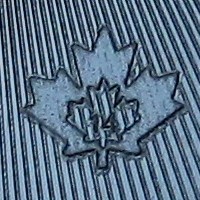
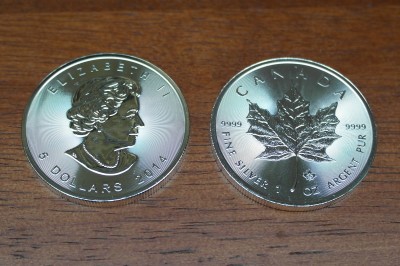
To invest more efficiently you can invest in bars of silver or “rounds” which are just like coins except that only the US Mint is allowed to make coins. Therefore if a company makes them, they are called rounds. You can get generic silver for $1.69 over spot for 1-ounce rounds or a 1-ounce bar, but a lot of that is going towards the “free” shipping and handling, so when you buy in quantities of 20, the price over spot drops to $1.24, getting you down to 6% over the spot price. Buying bigger bars gets you even better prices. The problem with the rounds and bars is they will only be worth scrap silver value when you want to sell them, whereas the coins might carry some additional value (I have no idea how much, and I suspect selling isn’t a picnic, though on Pawn Stars the owner of the store says he can make money buying scrap silver at 1% below spot; I wonder if all of these spot prices are the same: maybe there is a spot asking price they use to sell you stuff and a spot bidding price which they use to buy your stuff; JM Buillion only sells and I notice their spot price is generally a few cents higher than the current market price). One other problem with silver is that it tarnishes. I found out that the tarnish isn’t caused by oxidation like rust on iron, but from sulfur pollutants in the air. Keeping silver in ziplock baggies might keep the tarnish at bay. Polishing the silver is frowned upon because polishing also removes some of the silver.
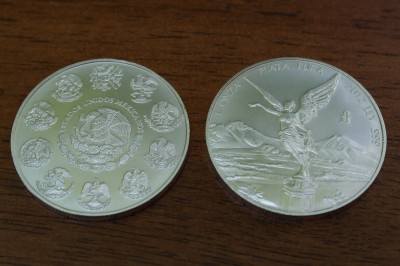
Some of the history of silver and money is pretty interesting. In the 1870’s the silver industry wanted the United States to set the price of silver at $1 per ounce. But some big silver mines were coming online like the Comstock Lode and the real price of silver was less than $1 and falling. Silver refiners wanted to be able to take their silver to the mint, pay a small fee, have the mint stamp the silver into coins, and then get it back in $1 US coins. Farmers also supported $1 silver thinking it would cause inflation and earn better prices for their crops. So the government agreed to buy a bunch of silver and produce $1 coins. That is how the Morgan dollars from the 1870’s and 1880’s came about. Eventually some of that died out, but in the 1900’s business interests once again pushed Congress into minting more silver coins (the Pittman Act was sponsored by a Senator from Nevada, where all the silver was mined), which is how the Peace dollars of the 1920’s came about (the Pittman Act melted a lot of the Morgan dollars, sold the silver to England, and replaced all of that with new Peace Dollars). Then a government stockpile of silver dollars was found in the 60’s and the government sold the coins at face value of $1. Another sale took place in the 70’s, but at market rates instead of face value. I think that’s how Mr. Tener (and eventually Dad and eventually all of us) ended up with a bunch of those, although those silver dollars actually contain about 3/4 of an ounce of silver each.
Private concerns have dabbled in silver currency as well. The “Liberty Dollar” was introduced by a guy trying to promote an alternate currency (reminiscent of Bitcoin). He figured he was okay by making it clear that the silver coins and paper bills (which could be redeemed for silver) were not legal tender, but the government shut him down anyway and took all of his silver. Live and learn.
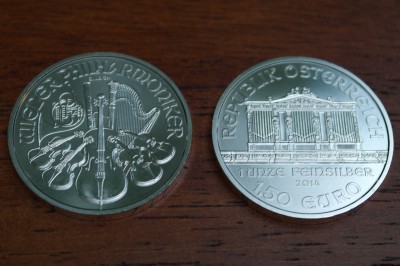
Besides silver and gold, you can also invest in platinum (around $1500 per oz.) and palladium ($810 per oz.). The mints in some countries make coins out of those less common metals (the US has a platinum coin and Canada has made palladium coins), but I think I will stay away from those for now. The US Mint looked into producing a palladium coin using the same design as the Mercury dime (not only do Mercury dimes contain no mercury, the image on the Mercury dime isn’t actually Mercury) in 2012, but decided against it. There probably isn’t a lot of demand from the public for palladium if they’ve never heard of it (palladium’s main industrial use seems to be in catalytic converters for cars). JM Bullion has started selling copper rounds and bars lately, but I’m not sure I see the point of that either. Copper is pretty cheap (21 cents per troy ounce) and the 1-ounce rounds cost $1. They’re just overpriced pennies.

I sold my shares of SLV today for about a 10% loss. But then I went back and bought new shares for my IRA. That way I don’t have to pay collectibles taxes in the unlikely event that the shares ever go up and I sell them for a profit. I sold the shares at Vanguard and bought them in my Fidelity IRA. I think that’s a wash sale technically, but maybe not since one of the accounts is an IRA.
I got my silver coins today. The American Silver Eagle is an impressive coin with a great design on front (obverse) and the Seal of the United States (or similar) on the reverse. But it is intentionally manufactured with a matte finish, plus there seems to be a white haze on parts of the coins I got. Shiny proof versions of the coin cost twice as much and contain no more silver, so I will have to live with lackluster Eagles. The Canadian Maple and the silver Vienna Philharmonic are much shinier and look great for the moment, but tarnish is inevitable. I hoped that JM Bullion would include zip lock bags like they did with the gold coins along with inexpensive anti-tarnish strips packed in. But the coins were packed only in plastic sleeves without ziplock bags or anything to stop tarnish (this would be a good add-on at checkout if they wanted to make more money). 3M makes anti-tarnish strips and tabs and I found a seller on eBay who will sell me more than enough for $2.50 shipped.